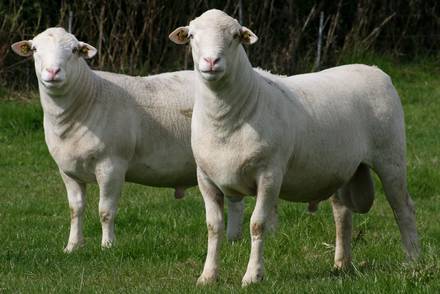Dorper sheep ideal for lamb market

Woolless, hornless sheep with good confirmation. Sounds too good to be true? Apparently not, according to Joe Adams, who imported 150 Dorper embryos in 2005.
Having already bred purebred Wiltshire Horn and Beltex and currently using Wiltshire sires over Beltex ewes, Mr Adams wanted to improve the easy-care characteristics of the sheep enterprise at Park House Farm, Northamptonshire.
“The aim was to breed a woolless, hornless sheep that can produce a lamb suited to the market,” explains Mr Adams. And, having started with a flock of 100 on his farm in New Zealand, demand is growing for Dorper and Wiltshire sires.
“Wool is a labour intensive, expensive commodity to produce, with little return. Typically, one shepherd looks after a flock of 3500 sheep in New Zealand. Take into account the time spent treating for fly strike, dagging and shearing and it equates to a large operation.

Joe Adams has imported a number of Dorper genetics to breed rams for the UK breeder
“In New Zealand, both Wiltshire Horn and Dorper breeding sheep are in short supply, as producers want to use these genetics to improve more traditional easier-care breed Romney and Romney cross ewes,” he says.
Ewes lambed in March 2006 following an embryo success rate of 55%. The following season, half the ewe lambs were put to a Wiltshire Horn ram, with these lambing in April/May this year.
Dorpers have a lambing percentage similar to that of other pure-bred ewes of typically 150%, explains Mr Adams.
When lambs are born, they have a good covering and are not bald as some would expect. “Both the Wiltshire and Dorper breeds are hardy at birth. Dorper lambs have get up and go second-to-none.”
Mr Adams now has 75 rams and females, all to be used for breeding stock, with rams currently for sale.
Fortunately, Mr Adams has enough different lines to establish a nucleus flock. And, in New Zealand, where the cross has taken off, embryo production has been implemented in many flocks to keep up with demand, something that if the breed is successful in the UK, he hopes to provide here.
Despite originating in South Africa, the Dorper breed has flourished worldwide, including through the harsh winters at 3000ft on Mr Adams’ farm in New Zealand. “The concern with any wool shedding sheep is that they are not going to be hardy enough to withstand climates, something both the Wiltshire and Dorper have dispelled,” he adds.
| The Droper Breed |
|---|
|
